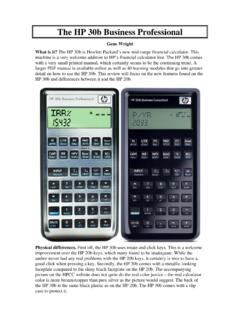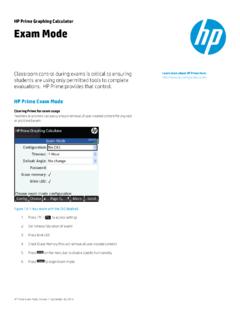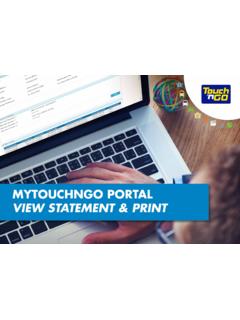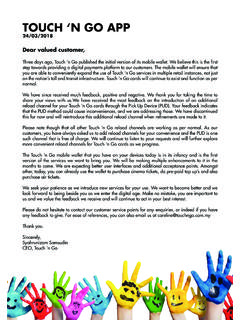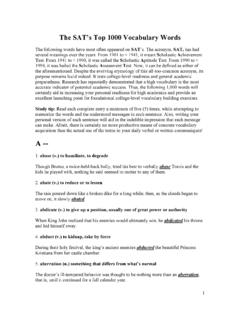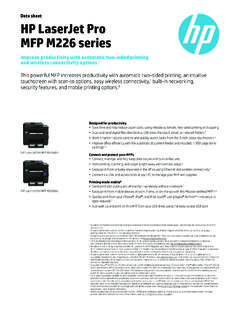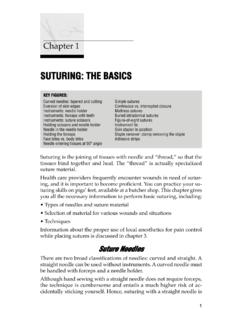Transcription of HP Prime Programming - HPCC
1 HP Prime : A Programmer's View Mark Power, It has been around eighteen months since the HP Prime hit the market, so I thought it really is about time that I wrote about my experiences. Wlodek observed in his 2014 AGM report that whilst there was interest in the HP Prime , it has been nothing like that when the HP-41, HP-71 or HP-48 families were introduced. This is a shame as it is the first real major shift from those architectures and brings us an affordable, state of the art calculator. Over the years I've progressed through a variety of machines: Commodore P50, TI-57, Casio fx-502p, Casio fx-702p, HP-41CV, HP-48SX, HP-48GX and now the HP Prime .
2 Each of these was purchased to run programs that I've written and each was sold to pay for the next model. The Commodore, TI and Casio calculators primarily ran maths programs that I wrote when I was at secondary school and sixth form. When I could finally afford them I moved over to HP when I went to university to study computer science. The HP-41 allowed me to write software in FOCAL and machine code that otherwise I would have had to get on my bike and cycle several miles to try out on the university minis and mainframes. Best of all, I. could carry these programs around with me. My use of calculators for calculating really peaked at university with differential equations, matrices, integration and differentiation, errors in computer systems and hexadecimal arithmetic.
3 Since leaving university, my use of maths has really regressed back to simple spreadsheets with the odd pie chart or graph. For this reason, I really feel that I'm totally unqualified to comment on the HP Prime 's maths capabilities. Indeed I have pressed the CAS button on a couple of occasions, played for a few minutes, thought to myself That's nice and went back to doing simple sums and graphs. So beyond simple maths programs, I've used programmable calculators as a platform for programs that people would use in their professions. On the Casio fx- 502p I wrote a program to help a friend's Dad with rates calculations when he worked for the local council.
4 On the HP-41 I wrote machine code routines to simplify entry of longitude and latitude for Colin Crowther so that he didn't have to worry about positive and negative value entry when flying Jumbo Jets. For myself I wrote a terminal emulator on the HP-48, which I recently ported to the HP-50 for a guy in the NHS who still uses the program to talk to medical equipment. As well as this serious stuff, for every single calculator I've owned I've written simple games to get the hang of the Programming language of the machine, determine its speed and generally show off the capability of a device that you can carry in your pocket.
5 Of course, we now have amazing toys like the iPod touch , iPhones and their clones that make our calculators, up to the HP-50g, look positively antiquated. So when presented with an HP Prime I was really exited to DATAFILE Vxx Nx Page 1. try out Programming a fast, colour touch screen machine with masses of storage and the obvious place to start was with a game. Programming on the go I mentioned the iPod touch , because my favourite game over the last few years has been a card game that it runs. This made me wonder how good the HP Prime would be at doing the same. I've tried a bit of iOS Programming and whilst it is clear that great things can be accomplished you need a full development environment, a lot of time to get the hang of the frameworks and libraries, and a laptop or desktop on which to do the development.
6 The great thing about the HP Prime is that while not perfect for on the go Programming , you can do it and without a massive learning curve. Indeed the Prime has some great features to help you with this: a reasonably straightforward BASIC like language, lots of memory to create copies of programs so that you can play without fear of destroying earlier versions and a very comprehensive built in help system so that you don't need to carry around a massive manual (though you can of course carry the PDF manual on your iDevice should you feel the need). The other reason why I wanted to try on the go Programming is that I don't actually own a PC and there is still, after eighteen months, no officially supported way to run the HP Prime software on a Mac - especially one as old as mine.
7 If you have a Mac with an Intel chipset, you can try using WINE to run the HP Prime emulator, or if you are feeling really brave you can try libhpcalcs, a very basic portable (Windows/MacOS X/Linux) connectivity kit library. This seems like a pretty basic problem for the HP Prime given how common Macs are now and a backwards step when you think that as far back as the HP-48S/SX you could use pretty much any development machine you liked because the calculator supported the Kermit file transfer protocol. Playing cards Back in Datafile V14N1 Joe Horn wrote a very neat card shuffler for the HP-48: This would be the foundation for my Prime Programming attempt, as the Prime supports list of numbers and would also allow me to get an idea as to how fast a calculator based on a modern ARM chip could be when freed from the overhead of emulating a Saturn architecture.
8 This is the code I settled on: NewDeckN(top). BEGIN. RETURN MAKELIST(I,I,1,top,1);. END;. Page 2 DATAFILE Vxx Nx NewDeck(). BEGIN. RETURN NewDeckN(52);. END;. Shuffle(). BEGIN. LOCAL c,l1,l2,l3,n;. NewDeck() l1;. FOR c FROM 1 TO 52 DO. RANDINT(1,SIZE(l1)-2) n;. SUB(l1,n+2,SIZE(l1)) l2;. SUB(l1,1,n) l3;. CONCAT(l2,l1(n+1),l3) l1;. END;. RETURN l1;. END;. As you can see, the code is significantly longer, but I've made it a bit more flexible than the original. NewDeck() creates a list containing the numbers 1 to 52. NewDeckN(n) in called by NewDeck() and creates an arbitrary list of numbers starting at 1 and going up to n using a single command.
9 Shuffle() uses NewDeck(). to create a deck of cards and then shuffles them. This last one is much less elegant than the original HP48 version as chopping up lists is a bit more involved. If you want to use these functions in programs of your own, you need to add EXPORT before the function name, otherwise they are local to the program file. Despite the size of these functions, particularly Shuffle(), they serve to show how fast the Prime is. Wrap them in a function like this: EXPORT TimeShuffle(n). BEGIN. LOCAL c, ts;. TICKS ts;. FOR c FROM 1 to n DO. Shuffle() L1;. END;. RETURN (TICKS-ts)/n/1000;. END;. Run TimeShuffle(100) and you'll see that the Shuffle() program runs in about Joe's original on the HP48GX took and my System RPL version in Datafile V15N21 took The modern hardware is certainly very quick.
10 If you look at my Shuffle() program you'll notice a few things: 1. DATAFILE Vxx Nx Page 3. 1. I have used to store values in variables. I have been asked on the MoHPC. forum how to enter this character. The answer is that it is by pressing Shift then EEX, which is labeled STO on the keyboard. This style of assignment is shown in the HP Prime User Guide in some places and was the one I. picked up on. Other programs in the User Guide use an alternative form of assignment which other people have picked up on as their first choice format: variable:=value;. This is easier to type on a PC, arguably more consistent with other languages and easier to pass around in a PC environment or print as it doesn't rely on a special character.

